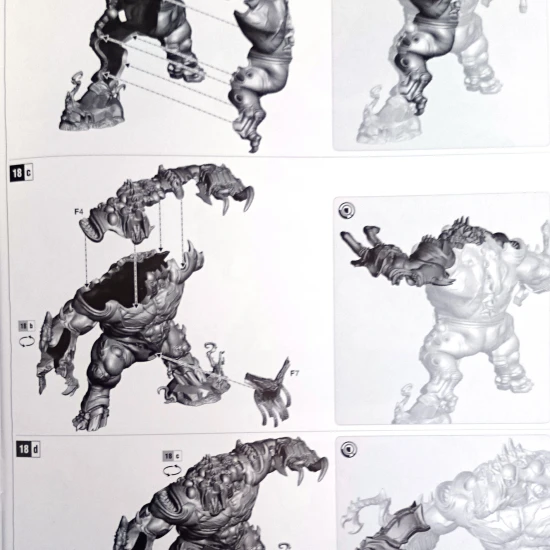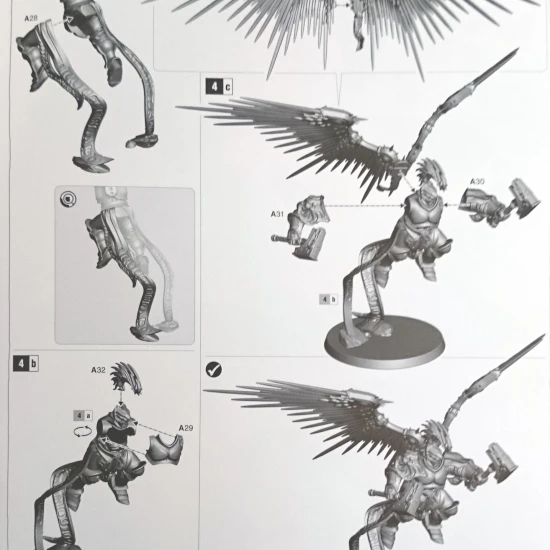If you have been following my blog or other websites on the release of the new Warhammer: Age of Sigmar game, you probably have seen what is included in the new starter set for Games Workshop’s new game. Games Workshop has released a couple of interesting videos on the contents of the Age of Sigmar starter box and have even uploaded a couple of videos on painting the new miniatures included in the box. In addition many websites have released unboxing videos or articles where you can read and watch what you will find the this new and (I think at least) exciting box.
Skipping the marketing blur from GW and the enthusiasm of other websites, I’ll be delving into the Warhammer: Age of Sigmar box as well. In this first impression of the Age of Sigmar starter box, I’ll be looking at the contents and what you’ll be getting from this new release. In addition, I’ll make some comments on the contents and what it really offers from a ‘gaming’ standpoint. After all, it seems that Games Workshop will be promoting this new set as an excellent introduction into the wonderful world of miniature gaming. But is the Age of Sigmar starter set a good entry point? What will boardgame fans get out of this set? And what are potential caveats and obstacles that new miniature gamers will face? Read on and find out what I think.
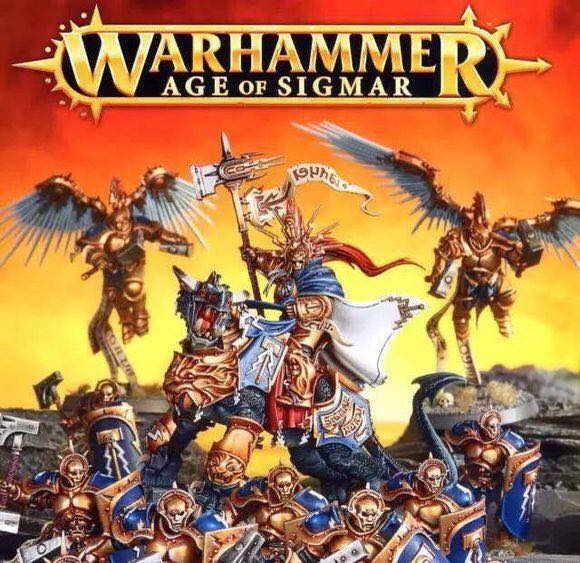
Entering a world of discoveries
As I’ve said in a previous blogpost, the Age of Sigmar game offers a lot of potential to discover new worlds in an entirely new Warhammer setting. The Old World is gone and instead we now have a magical world divided into nine entirely different realms. These realms are based on the eight Winds of Magic from the original Warhammer game and the Realm of Chaos where the evil Gods reside. Each realm is said to have a unique and distinct character. However, until now we know very little about the different realms as there are only a few brief descriptions on the character and theme of the nine realms that make up the Age of Sigmar universe.
With the Warhammer: Age of Sigmar starter set you’ll start your discovery into the first realm of the Age of Sigmar world. This is the Realm of Aqshy – or in more ‘common language’ the Realm of Fire. –A realm of anger, aggression and boiling heat. But also a realm where the surviving population is terrorised by evil ‘Bloodbound’ warriors who worship the Chaos Blood god Khorne. These Bloodbound warriors are the evil faction that is included in the starter set and are Sigmar’s main adversaries thus far. It is in this Realm of Fire that the story of Sigmar’s re-conquest of the magical realms begins. And as a player you’ll be part of this story as you’ll be fighting your way through a number of scenarios that will drive both the background story and the games you’ll be playing.
However, the Age of Sigmar starter box is more than a starting point for new background stories. It also offers us our first taste of what is to come in this new miniatures game. In that sense, the Age of Sigmar starter box is also a world of discovery for us gamers. Taking the centre stage in this age of discovery are the new miniatures included in the box. Miniatures with an entirely new aesthetic. Naturally the Stormcast Ethernal warriors being the prime example of this, but the evil Khorne Bloodbound warriors have also seen a great change when compared to the older Warhammer Fantasy Chaos warriors. In addition, this new starter set is also the first true tryout for an entirely new ruleset. Finally does the Age of Sigmar starter set give us an introduction to the of new armies that will eventually form the backbone of this game. In other words: the Age of Sigmar stater box offers a journey of discovery in a promising new gaming world. But how does this ‘introduction’ hold up? Let’s start with looking what you get!
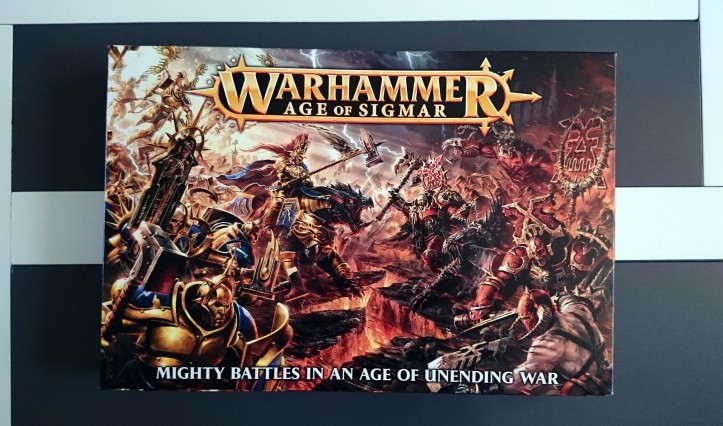
Box contents
Although weight is a lousy indicator of what you are getting, it does feel nice when you buy a game and it ‘feels’ like you are getting ‘worth’ for your money. Like most Games Workshop boxed games, Age of Sigmar does not disappoint in this department. When walking away with the Age of Sigmar box, you get the feeling that you spent your money in a rewarding way. The game also looks good on the outside, with a ‘classic’ or ‘retro’ look to the logo and lettering and an impressive and colourful piece of artwork decorating the box. Looking at the back side of the box, you get immediately drawn into the world of Age of Sigmar. Fully painted miniatures in a beautiful scenic battlefield – as is common practice with GW boxes – really set the tone for this game. Finally the rear shows the usual information for a game of this type: a short story about ‘what you are fighting for,’ an index with box contents, true scale pictures of two miniatures and a hefty ‘Warning’ about the ‘small parts’.
On the inside
After removing the shrink wrap and opening the box, you are welcomed by the goodness that miniature gamers call ‘sprues’. Sprues that are, unsurprisingly for recent Games Workshop products, packed with small parts that will eventually make up your miniature and armies. What did slightly amaze however, was the fact that it seems that there are more parts on the sprues than ever before. This is a huge contrast with the days when I started with Warhammer in the mid 1990-ies. In those days the sprues were largely ‘empty’ and the ‘distance’ between the different parts was fairly large. But over the years – and probably with the development of injection mould technology – Games Workshop has been able to put more and more pieces on each sprue. This means that, even though there are only five sprues in the box, you still get 47 large miniatures.
After removing the sprues from the box, you’ll find a plastic packed set of booklets (including the ‘infamous’ four page rule set), a bag of dice, bases for your miniatures and two sheets of ‘waterslide transfers.’ These sticker like decals can be used to decorate your Sigmarite Stormcast Eternals in an easy way, saving you time and effort when painting these miniatures. It’s important to note that there are no transfers for your Khornate warriors. This may seem like a shame, but the Khornate warriors are so richly detailed that it would probably not be possible to put these decals anywhere.
Finally there is one large disappointment: the included ‘flappy stick’ range rulers. Warhammer players will be familiar with these measuring sticks, and I have to admit that these ‘new’ blue coloured sticks are an improvement over the old always bend red range rulers, but in a time where more and more companies include a spring rule measuring tape this is a bit of a sorry cost saver. Still, the initial impression is positive as you get a good amount of content in the box that at first glance seems to be carefully designed and thought through. So what are those sprues like?

Sprues with goodies
Like I said before: the miniatures are the showpiece of this new boxed set. Divided between five sprues (two of identical) you will find two full warbands that you’ll use for your battles in Warhammer: Age of Sigmar. And in this set we see two trends in Games Workshop starter box design. The first trend will please existing miniature gamers and miniature collectors as the level of detail is truly exceptional. All models are covered in fine and clear detail. Armour plates have sharp lines, scrolls feature fine ‘fantasy script and the Khorne warriors have the supersized six-packs, scars and skulls we would expect from ‘evil’ Blood god worshipping fighters.
Another pleasing trend in GW starter boxes is the way the armies are thought out. Coming from the 5th edition of Warhammer Fantasy, all you got were a couple of rank-and-file troops and knights. Over the years these basic troops were joined by command groups (champions, banner bearers and musicians) as upgrades for the common soldiers. Then, heroes and more unique units joined the action. And now you get a great variation for troops, heroes and ‘centre piece models’: rank-and-file troopers, specialist and elite troops, heroes and finally large monsters that are real eye catchers.
In general, I think that GW has also managed to get two very distinct and characterful strike forces in the Age of Sigmar starter box. On one hand you have the knights and shining armour in the form of the Stormcast Eternals – and army that my wife as ‘knight’ fan has already confiscated – while at the other hand you get a selection of barbarian, norse themed warriors with loads of spikes. All in all a great contrast in smooth knights and spiky barbarians, of shining armour and dark tones and of honour and bloodlust. All in all I think that Age of Sigmar strikes a great balance between the look and feel of the armies, the different troop types in the two armies and the balance between characters (heroes) and common soldiers.
There is one big but I have to add: as an introduction set for people who are new to the wargaming hobby. This comment concerns the complexity of the models in the Warhammer: Age of Sigmar set. Unlike previous starter sets (ranging from the 5th edition of Warhammer Fantasy all the way up to the 8th edition starter set), the models in the Age of Sigmar starter set are NOT push fit miniatures. Indeed, some miniatures have as many as ten parts. And while this may not be an issue for the more experienced wargamer, this is can be quite daunting for newcomers and more inexperienced war gamers. This means that newcomers might want to look up some instruction videos on the internet to learn a bit about assembling miniatures and modelling techniques in general.
Another (smaller) issue is the placement of some of the ‘connections’ on the sprue. In general the placement is much better than the connection on the ‘free’ Stormcast Eternal Liberator that was included in with the last White Dwarf magazine. Still, there are some bits that you have to remove very careful from the sprue to avoid unwanted breaking of parts to causing unwanted damage to the parts.
In conclusion I’d have to say that Games Workshop have outdone themselves with the miniatures included in the starterset. The miniatures are richly detailed, fairly easy to assemble and of the highest quality ever seen in a Games Workshop starter set. They may not be the best miniatures ever produced by GW, but the gap there was between ‘starter set minis’ and individual kits you’d buy as an expansion for your army has never been smaller. Something you can judge for yourself in the pictures and closeups I’ve taken from the different sprues. The only big problem I have, is the fact that assembling this new starter set has not been this hard in ages. There are no snap fit miniatures included, and while the design and ‘cutting’ of the figurines has been well thought out, this is a challenge for people wanting to get into the wargaming hobby. A hurdle that could have been avoided I think.
Assembly instructions
Fortunately for us gamers, Games Workshop has also made progress in the assembly instructions for their figurines. This means that the instructions included in the Warhammer: Age of Sigmar set also are some of the best they have ever made. Of course, this does not solve the problem of complexity for newcomers, but it does make the challenge of assembling these minis less frightening. All models in the box are described in a ‘LEGO’ style instruction. Difficult parts of the miniature also have an ‘opposite’ view for the parts so you can see exactly how the parts should fit together. In addition, all parts on the sprues are labelled. This labelling system follows two parts: each sprue has a ‘letter’ and each part on a sprue has a number. These parts are referenced to in the assembly instructions as “B1, B2, B3” etc. All in all I think that – although I have to note that I am a veteran wargamer – the entry level is greatly reduced. It does not remove the barrier, but the barrier is significantly lowered. But you can see for yourself in some of the photos below.
Paperwork
Even though a game can have the best components in the World, any gamer will tell you that the rules of a game matter more than the components. Gameplay above graphics as videogame players would say. I will not delve too deep into the rules of Warhammer: Age of Sigmar as I’ve already written quite a thorough impression of the Age of Sigmar rules. A summary of that article would be that the rules offer great possibilities, but that there are still a lot of questions. Questions that concern balance, but also some wording issues. In addition, even though the basic framework is only four pages, the so called Warscrolls – special reference sheets that detail all the abilities of your miniatures – add a lot of extra ‘special rules’ and abilities. In a sense, the depth of Warhammer: Age of Sigmar comes from these Warscrolls and the rule set is only the ‘foundation’ upon which these Warscrolls build and expand.
(Impressions continue below this image)
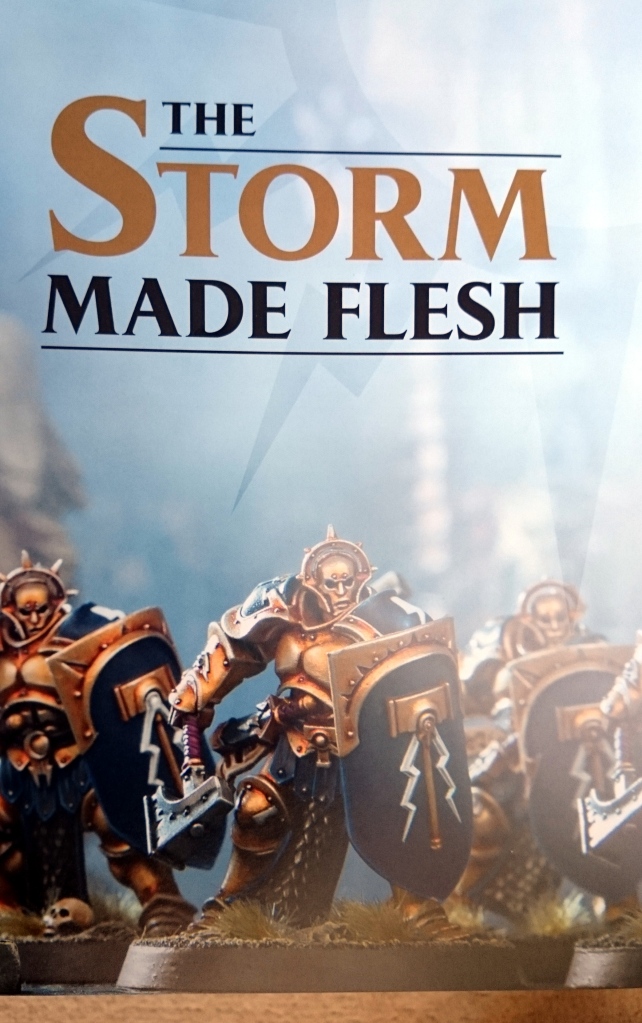
Based on my experience with Games Workshop, the paperwork of Warhammer: Age of Sigmar does not disappoint. GW is of course known for their high production values, and the Age of Sigmar book illustrates this again: the 96 page Age of Sigmar booklet is simply stunning. It is a full colour production featuring stunningly photographed miniatures and great artwork (see the image above for an idea). In addition, as the rules are separate, the book is very well laid out. The first section covers a rough outline of the world you are fighting in, followed by a section that details the background stories of all the miniatures included. Finally you will find some ‘colour schemes’ that you could use to paint your miniatures and a rather detailed description of how you can paint the miniatures in “Games Workshop style.”
The best part for me was the scenario and narrative part of the book. This part – called Fire and Thunder – details the beginning of Sigmar’s forces striking back against the evil powers of Chaos. As I had predicted in my ‘looking forward’ post, narrative based games play a very important part in the Age of Sigmar set. The Age of Sigmar book details six scenarios, all part of a larger narrative, that is accompanied by a page of background story. Each scenario that you’ll play in this six battles sized campaign continues the storyline of previous battles. A system that we also know from dungeon crawler games like Dungeons & Dragons Adventure board games, Descent: Journeys in the Dark and the upcoming Dungeon Saga – a game I’ll look into very soon. –
Like the campaign sets ‘Stormclaw’ and ‘Shield of Baal’ that Games Workshop released and for Warhammer 40,000, Warhammer: Age of Sigmar follows an introduction that slowly emerges and introduces the player into the workings of the game. This starts with a battle between the Lord-Celestant of the Stormcast Eternal warriors (the centrepiece model for this faction) against a Bloodstoker and Khorgorath (the evil monster and his herder). From here the battles scale up both in model count and in ‘tabletop’ size until you finally play a battle with all minis included in the starter set and any additional minis you want to include.
I think that this gradual introduction is a good thing as it introduces you in a nice, non intimidating way into the complexities of the game. At the same time these small battles are incorporated in a larger narrative that is telling a coherent story why these battles are happening. Further, it opens up and sets the tone for a new expansion that will be released next week. In this campaign, the story that started in the Age of Sigmar starter box will continue and expand.
Looking at the entire mix of paperwork that you get with Age of Sigmar, I think that you get a sleek and fast playing rule set that still needs quite a bit of work. The rules allow for fun and fast paced battles while they have more depth than is apparent at initial glance. This is caused because the real depth comes from the varying Warscrolls that detail the abilities of your models. The biggest benefit of the rule set for Age of Sigmar has to be that it is one of the easiest to learn AND teach rule sets in the miniature games world. And that offers potential for newcomers who though that Warhammer was too complex. What I also like is the richly illustrated Age of Sigmar book. This book has great photo’s, some nice artwork, a cool introduction campaign and the beginnings of what could be a great background setting for upcoming games. It may not be perfect, but it has the high quality feel of GW that we have come to expect.
Not a game in a box
If there is one thing that has to be disappointing for board gamers, it has to be the fact that Warhammer: Age of Sigmar is NOT a game-in-a-box. Yes, it is perfectly possible to play Age of Sigmar straight from the starter set (aside the considerable time needed for assembly), but with the Age of Sigmar starter set you do not get the entire ‘Warhammer: AoS’ experience. Something more and more miniature game companies have come to understand as they release introduction sets such as the set for Dropzone Commander or Infinity – Operation: Icestorm that include not only the models, but also a ‘gaming mat’ and ‘scenery’ to support the basic gameplay.
In the case of Warhammer: Age of Sigmar you first need ‘hobby essentials.’ These hobby essentials are things like plastic glue, clippers and a hobby knife so you can assemble your models. As painting is not required to enjoy the game I will leave them out (and also because these are not included in any other starter box) but you could take that into account also if you want to go ‘full in’.
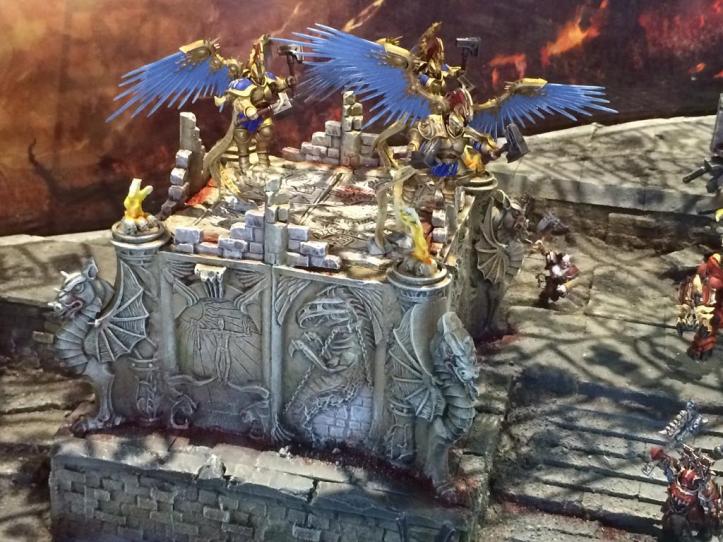
Besides the hobby essentials, you’d need to get some terrain pieces – or scenery as it’s also called – that gives your troops some cover against shooting and magic attacks and offer benefits or constrains to your soldiers while moving around. Admittingly, most scenerios in Warhammer: Age of Sigmar do not dictate that you’d use scenery, but from my experience I can say that a battle without scenery is playing a game of chess with only the kings moving around. You simply miss a big part of the entire ‘wargaming’ experience. Of course it is perfectly possible to play a game without scenery or ‘proxy’ pieces such as books for hills and pieces of paper that stand in for trees and forests. That however, is just not what you’d want from such a game.
It is perfectly understandable that Games Workshop did not include scenery in their starter set. Scenery takes a lot of space, would add to the price of the starter box and thus make it less competitively priced. However, from the point of seeing this boxed set as a ‘full introduction’ into miniatures wargames and Games Workshop’s Warhammer: Age of Sigmar hobby it is a missed chance, especially now it’s competitors are increasingly flirting with non miniature gamers also and also have compelling systems, miniatures and (more and more) starter sets.
Is Age of Sigmar a bad point to start as a non-wargamer? No, I think it is not. In fact: there are no competitors in the miniature games business that offer a more clear and easy to learn rule set. Also, unlike previous Games Workshop starter sets, you get enough miniatures to fight a decent game as Warhammer: Age of Sigmar is designed for more ‘focussed’ and ‘small scale’ games. This is a big shift from the older Warhammer Fantasy and also Warhammer 40,000 starter sets and brings in mind old (discontinued) games such as GorkaMorka, Bloodbowl or Mordheim. In addition: the miniatures you are getting are of a really high quality and – even though they are not snap fit – thanks to the excellent assembly instructions fairly easy to assemble. Just do not expect to get the ‘full fat’ experience from this box. To get that experience you’d need to invest in some scenery pieces, a green table cloth (or gaming mat) to enhance your battlefields and games.
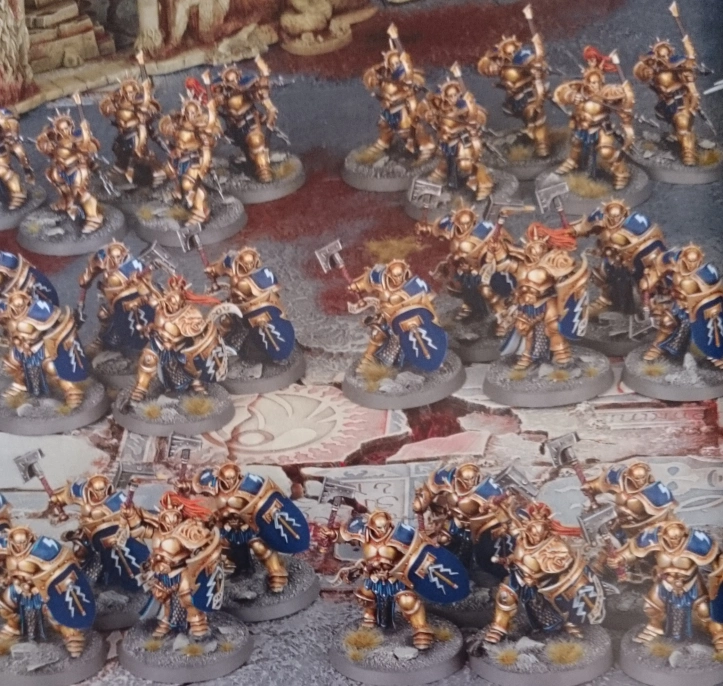
Initial Conclusion
Warhammer: Age of Sigmar has the foundations for a game that can have a long life and become a true hobby. The rules allow for great expandability and the seeds are sown for nice narrative based battles. Also, in terms of miniatures you are getting great value here as you get two factions that allow for descent sized games (something that the starter sets for Warhammer 40,000 and Warhammer Fantasy lacked). The models are of great quality – I would even say stunning if it wasn’t for the ‘art style’ that might not be to every person’s taste. –
Age of Sigmar however is NOT a full boxed game: a game that and needs no expansions to get the full fat experience. It lacks extra´s like scenery and a gaming mat that make the experience complete. Something that other competitors do have these days. In terms of background, artwork and potential can I say that Age of Sigmar is really good. Especially now I’ve seen the narrative potential of these games, the balancing issue with the rules suddenly becomes far less of a problem. And as a large fan of narrative driven games, having a story focussed ‘miniatures game’ is something I might have been looking for without really knowing.

Age of Sigmar does not exist in a lonely universe however. More and more miniature companies are lurking around: planning to make an attack on your pay check, wallet or credit card. And these games offer some potential also. Warmachine/Hordes offers miniatures in an art style that seems closer to Age of Sigmar than it was to Warhammer Fantasy (would GW have copied their style?). In addition, this game can be played rather cheaply and already has a considerate following. It does have the same problem as Warhammer: Age of Sigmar in the sense that is does not offer a ‘game-in-a-box’ experience. Indeed, the Age of Sigmar box might be more compelling when comparing components, rules and art direction. Also Warmahordes is more complicated in terms of rules…
Two entirely different games but also miniature games that are getting more attention every day are Dropzone Commander and Infinity. Both these games offer true ‘game-in-a-box’ experiences and both are well received. They might be harder to get into as there are less players than Warhammer Fantasy had – it remains to be seen though what the success of Age of Sigmar will be – while the rules are quite a bit more complicated. Dropzone Commander also has another scale, with very tiny miniatures, that might scare you away. Infinity on the other hand uses roughly same scale miniatures but miniatures that are very ‘clean’ and therefore considered harder to paint. Still in a market that is more competitive than ever, choice can only be a good thing right?
So there you have it: the “Warhammer: Age of Sigmar” is out and offers great minis and a very reasonable price. The background stories are more existing and emerging than I expected and the narrative driven focus is something I have been looking for for quite some time. As expected are the production values for Age of Sigmar excellent, both in minis, art direction, photography and presentation. The rules still need some working, but this issue is far less pronounced in the scenarios than it would be in ‘pick-up and drop-in’ games at a gaming club or in a tournament. I can’t fault you if you are still in doubt on this new game. In that case however, try the free rules online. Else if you like minis and are looking for a new experience: Age of Sigmar is better than you might think 🙂
















